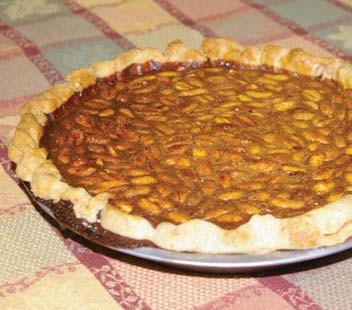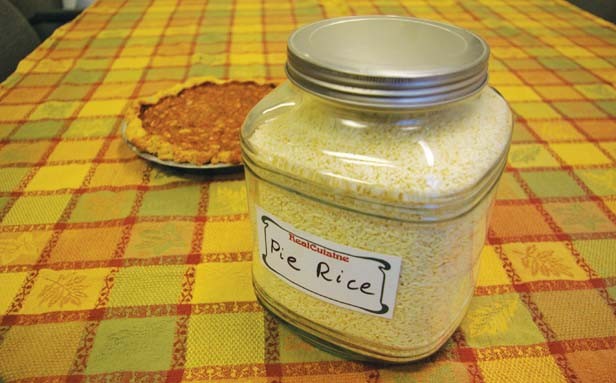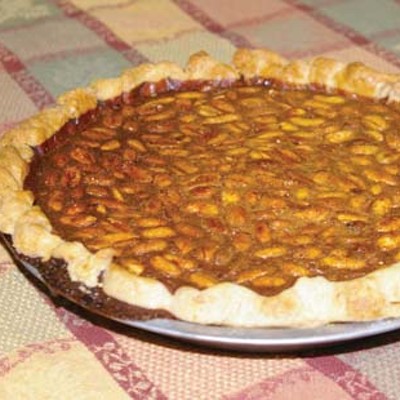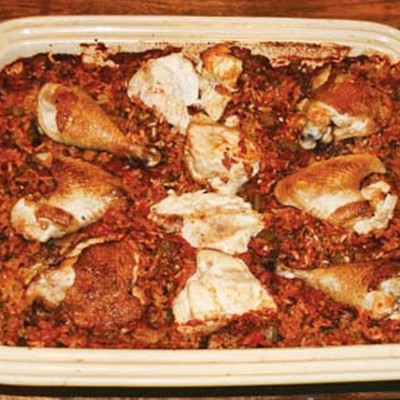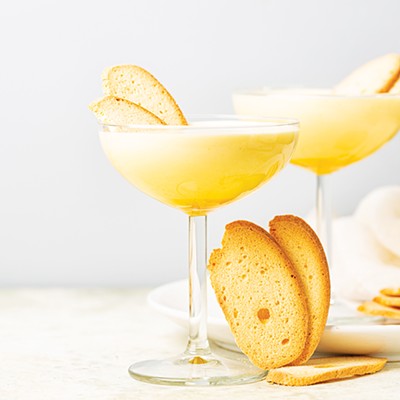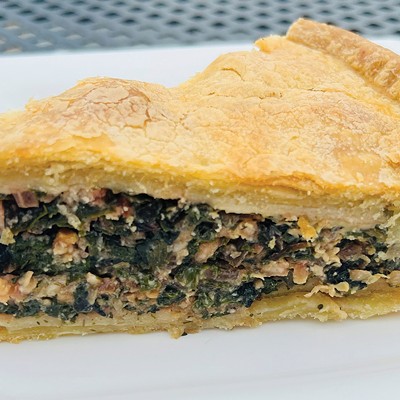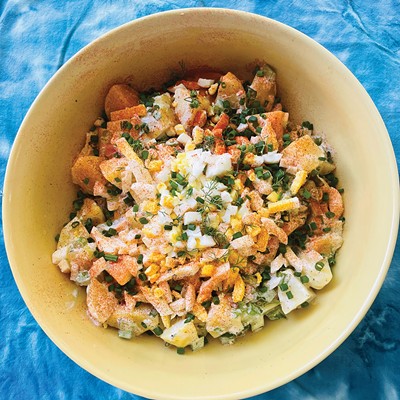Pate Brisee
(aka pie pastry)
For 2 crusts:
• 2 1/2 c. unbleached all-purpose flour
• 1 tsp. salt
• 1 T. sugar
• 1/2 c. EACH unsalted butter and unhydrogenated lard, preferred, or 1 c. unsalted butter
• 1/3-1/2 c. ice water
All ingredients and utensils MUST be cold or cool.
To make pastry in a food processor: Cut the butter into small pieces and freeze. If using lard, spread on a small plate and freeze.
Put the flour, sugar and salt in the food processor’s bowl. Cut the frozen lard into pieces and add to the bowl along with the frozen butter. Turn on the processor and IMMEDIATELY pour in the ice water (without ice pieces). Process JUST until the mixture is combined and forms a crumbly mass. Test by pinching a bit of dough between two fingers. If it holds its shape, it’s ready. If not, add more ice water by tablespoons. DON’T OVER PROCESS! Working quickly so the ingredients stay cold, turn dough out onto a floured surface. Gather it into a rectangular mass and knead three or four times with the heel of your hand pushing outward, a process called fraisage. Fraised dough has more elasticity and less tendency to crack around the edges when rolled. Enough gluten develops so it’s easier to roll, but not enough to toughen it. Fraisage flattens the bits of cold shortening between the dough, ensuring flakier pastry.
Divide the dough in half. If using only one crust, flatten one half into an approximately 6-inch disc. Wrap tightly in plastic wrap; freeze for later use. Form the other half into a similar disc, turn onto a floured surface. Roll with a floured rolling pin using light strokes from the middle outward, rotating as you roll. Sprinkle JUST enough flour onto the rolling pin, dough and rolling surface to avoid sticking.
If making pastry with a pastry cutter or two knives, cut the shortening into small pieces. Chill well. Put the flour, salt and sugar in a large bowl; add the shortening. Cut it into the flour until it resembles coarse meal. Stop when there are pea-sized clumps of shortening. Drizzle in 1/3 cup ice water; stir until the dough begins coming together. DO NOT OVERWORK! Add more water by tablespoons if necessary. Test and proceed as above.
For whole-wheat pastry: Replace 1 cup of the unbleached all-purpose flour with 1 cup white whole-wheat flour or whole-wheat pastry flour.
For sesame seed pastry: Mix 2 tablespoons lightly toasted sesame seeds with the flour, salt and sugar before adding the shortening.
To prebake or partially bake a pie or tart shell: Preheat the oven to 425. Fit the rolled-out pastry into the pan. Check for holes or cracks; patch any with extra pastry lightly brushed with beaten egg or water. Freeze for at least 15 minutes, then gently press heavy-duty aluminum foil into the shell’s bottom and sides with as few wrinkles as possible. Fill the foil with rice or dried beans. Bake for 15 minutes. Remove the shell from the oven. Pull foil’s corners inward so they don’t tear the crust’s edges. Grab two corners of the foil in each hand; lift straight up to remove the foil and rice or beans. The beans/rice can be reused indefinitely. Brush the shell’s bottom and sides with beaten egg and return to the oven.
For a partially baked shell, bake 2-3 minutes longer until the egg is set. To completely bake the shell, bake an additional 8-10 minutes or until lightly browned.
Tips for making pie pastry
• Keep all ingredients cold.
• Remember: The goal is to make dough that holds together without completely emulsifying the shortening into the flour.
• Don’t overwork the dough.
• Don’t be afraid to patch the pastry with a little cold water or beaten egg.
• When rolling out the pastry, use just enough flour to keep the dough from sticking – dust off excess flour before baking.
• Make sure there are no cracks or holes in the bottom crust before pouring in the filling – patch with extra dough or seal with a little beaten egg, then bake a few minutes until set.
• Use pans that conduct heat well – perforated-bottomed pans work best; if using disposable aluminum pans (they work extremely well), lightly pierce their bottoms with a sharp paring knife a few times.
• Always prebake crusts of single (bottom) crust pies, and then seal them by brushing lightly with a little beaten egg.
• For double crust pies, make the filling before rolling out the top crust, then pour in the filling, immediately cover with the top crust, and put in the oven.
• For single crust pies, pour fillings that require additional baking into the crust immediately before returning to the oven. Fillings that will be refrigerated should be cooled to room temperature before pouring into a completely baked and cooled pie shell.

